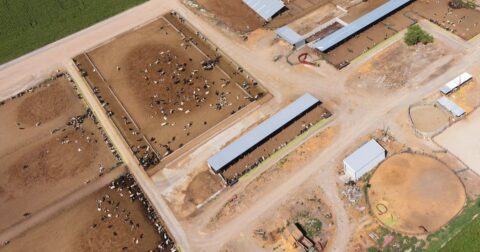Perspective
Critics Declared Veganism Dead in 2025. Here’s What Those Obituaries Are Missing.
Food•5 min read
Perspective
To address the climate crisis, biodiversity loss, and the ongoing threat of zoonotic disease, advocates must turn their calls for divestment to the factory farming industry.

Perspective • Food • Industry

Words by Merel Van Der Mark
For decades, advocates have focused on the need to divest from fossil fuels. Now, to address the climate crisis, biodiversity loss, and the ongoing threat of zoonotic disease, advocates must turn their calls for divestment to the factory farming industry.
This week, development finance institutions gathered at the Finance in Common Summit, the first-ever global meeting of all public development banks. The event is meant to host discussions on how to reconcile the entire finance community in support of common action for climate and the UN Sustainable Development Goals (SDGs). Neither the SDGs nor the Paris Climate Agreement goals will be reached without divestment from industrial livestock.
Animal agriculture fuels the climate crisis, responsible for more than 14.5 percent of anthropogenic greenhouse gas emissions globally. If nothing changes, experts project it could account for up to half of the world’s allowable greenhouse gas emissions by 2030, for a 1.5°C temperature increase scenario. Even worse, it is expected to be responsible for 80 percent of emissions by 2050.
The livestock sector is also a major driver of deforestation, with rainforests and savannas in South America—such as the Amazon, the Chaco, and the Cerrado—turned into pastures for cattle or crop fields for animal feed. This process causes huge biodiversity loss, increasing the fragility of vital ecosystems.
Deforestation is often associated with land conflicts and exacerbates existing inequalities. Indigenous peoples and local communities face displacement, loss of livelihoods, criminalization, and violence. In the Global South and countries such as Brazil, the largest beef exporter in the world, cattle ranching is also frequently linked to contemporary slave labor.
Changes in the environment, such as those caused by deforestation linked to livestock production, can also be drivers for the emergence of new zoonotic diseases, according to the United Nations Environment Programme (UNEP). At the same time, industrial animal agriculture, in which animals are raised in overcrowded, filthy factory farms, are also potential breeding grounds for zoonosis. The spread of COVID-19 in mink farms in Denmark is just an example of how industrial livestock farms can contribute to the spreading of zoonotic diseases.
A shift away from industrial livestock would also help meet the second SDG: Zero Hunger. While the production of meat, fish from aquaculture, eggs, and dairy, requires around 83 percent of the world’s farmland, it provides only 37 percent of our protein and 18 percent of our calories. Scientists say that if the grains used as animal feed were instead used for direct human consumption an extra four billion people could be fed.
At the same time, plant-based diets would have many human health benefits, as high levels of consumption of animal products contribute to heart disease, diabetes, and certain cancers.
A divestment in industrial livestock operations would also benefit public health, as it would lead to a significant reduction in the use of antibiotics. In some countries, up to 80 percent of the total consumption of medically important antibiotics happens in the livestock sector. This misuse of these medicines leads to antibiotic resistance, which undermines the efficacy of these drugs in human medicine. This is already the cause of 700,000 deaths every year, according to the World Health Organization (WHO).
The industrial livestock sector also causes pain and suffering to billions of animals. Most are kept in very small cages or overcrowded spaces for their entire lives, sometimes barely able to walk freely or turn around, standing in their own excrements. They are exposed to high levels of stress and can not carry out their most basic natural behaviors. In their shortened lives, many will suffer painful mutilations, face excruciating boredom, and many will never see the sun.
Despite these reasons to divest from factory farms, an investigation has revealed that, in the past 10 years, major development banks—such as the World Bank and European Bank for Reconstruction and Development—have lent $2.6 billion for pig, poultry, and beef farming, as well as dairy and meat processing.
These institutions are often funded with tax money, meaning development banks are distributing our money to make investments that can jeopardize the future on this planet. Their budget is channeled to large multinational corporations contributing to increased social inequalities and leading to significant environmental and social impacts while creating a few, mostly badly paid jobs.
Instead, development banks should invest in projects that promote resilient and sustainable food systems, that invest in local food production and supply chains, and smallholder farmers. We need to guarantee the production of healthy and sustainable food for all.
We hope that, when they gathered in Paris, development banks refreshed their memories. Nearly five years ago, world leaders adopted the Paris Agreement, agreeing to boldly cut greenhouse gas emissions to assure our survival. We hope this weighs on the banks’ decisions. A commitment to divest from factory farming is fundamental for climate mitigation, the promotion of global biodiversity, and the prevention of future pandemics. Development banks must live up to their mission and take the measures needed to protect our planet, its people, and animals while redirecting funds to sustainable agricultural practices instead.
You can join this campaign and take simple actions to ask development banks to stop funding factory farms at www.divestfactoryfarming.org.